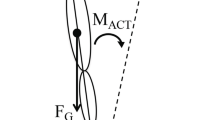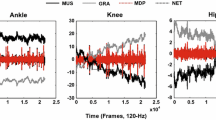Abstract
Whole body coordination is essential for maintaining human posture stability. Yet the control goals and influences of individual differences and task-related effects have not been well investigated. Uncontrolled manifold method was used to assess whole-body coordination during upright stance with 16 young and 16 older individuals. These ratios were obtained for the head, shoulder, and whole-body center-of-mass, in both the mediolateral and anteroposterior directions. As evidenced by larger uncontrolled manifold ratios, the head and shoulder appeared to be more likely than whole-body center-of-mass as control goals for whole body coordination. The present results demonstrate that investigation of head and shoulder kinematics among upright stance posture could be likely yielding clinical meaningful results.
Access this chapter
Tax calculation will be finalised at checkout
Purchases are for personal use only
Similar content being viewed by others
References
Peterka, R.J.: Sensorimotor integration in human postural control. J. Neurophysiol. 88, 1097–1118 (2002)
Peterka, R.J.: Postural control model interpretation of stabilogram diffusion analysis. Biol. Cybern. 82, 335–343 (2000)
Winter, D.A.: Biomechanics and Motor Control of Human Movement. Wiley, Hoboken (2009)
Pinter, I.J., Van Swigchem, R., van Soest, A.J.K., Rozendaal, L.A.: The dynamics of postural sway cannot be captured using a one-segment inverted pendulum model: a PCA on segment rotations during unperturbed stance. J. Neurophysiol. 100, 3197–3208 (2008)
Zhang, H., Nussbaum, M.A., Agnew, M.J.: Use of wavelet coherence to assess two-joint coordination during quiet upright stance. J. Electromyogr. Kinesiol. 24, 607–613 (2014)
Kiemel, T., Elahi, A.J., Jeka, J.J.: Identification of the plant for upright stance in humans: multiple movement patterns from a single neural strategy. J. Neurophysiol. 100, 3394–3406 (2008)
Hsu, W.L., Scholz, J.P., Schöner, G., Jeka, J.J., Kiemel, T.: Control and estimation of posture during quiet stance depends on multijoint coordination. J. Neurophysiol. 97, 3024 (2007)
Alexandrov, A., Frolov, A., Massion, J.: Axial synergies during human upper trunk bending. Exp. Brain Res. 118, 210–220 (1998)
Krishnamoorthy, V., Yang, J.F., Scholz, J.P.: Joint coordination during quiet stance: effects of vision. Exp. Brain Res. 164, 1–17 (2005)
Zhang, H., Nussbaum, M.A., Agnew, M.J.: Development of a sliding mode control model for quiet upright stance. Med. Eng. Phys. 38, 204–208 (2016)
Zhang, H., Nussbaum, M.A., Agnew, M.J.: A new method to assess passive and active ankle stiffness during quiet upright stance. J. Electromyogr. Kinesiol. 25, 937–943 (2015)
Gaffney, B.M., Harris, M.D., Davidson, B.S., Stevens-Lapsley, J.E., Christiansen, C.L., Shelburne, K.B.: Multi-joint compensatory effects of unilateral total knee arthroplasty during high-demand tasks. Ann. Biomed. Eng. 44, 1–13 (2016)
Peng, Y., He, J., Khavari, R., Boone, T.B., Zhang, Y.: Functional mapping of the pelvic floor and sphincter muscles from high-density surface EMG recordings. Int. Urogynecol. J. 27(11), 1689–1696 (2016). https://doi.org/10.1007/s00192-016-3026-4
Peng, Y., He, J., Yao, B., Li, S., Zhou, P., Zhang, Y.: Motor unit number estimation based on high-density surface electromyography decomposition. Clin. Neurophysiol. 127, 3059–3065 (2016)
Reisman, D.S., Scholz, J.P., Schoner, G.: Coordination underlying the control of whole body momentum during sit-to-stand. Gait Posture 15, 45–55 (2002)
Massion, J., Popov, K., Fabre, J.C., Rage, P., Gurfinkel, V.: Is the erect posture in microgravity based on the control of trunk orientation or center of mass position? Exp. Brain Res. 114, 384–389 (1997)
Ferry, M., Martin, L., Termoz, N., Cote, J., Prince, F.: Balance control during an arm raising movement in bipedal stance: which biomechanical factor is controlled? Biol. Cybern. 91, 104–114 (2004)
DiFabio, R.P., Emasithi, A.: Aging and the mechanisms underlying head and postural control during voluntary motion. Phys. Ther. 77, 458–475 (1997)
Ledebt, A., WienerVacher, S.: Head coordination in the sagittal plane in toddlers during walking: Preliminary results. Brain Res. Bull. 40, 371–373 (1996)
Mouchnino, L., Aurenty, R., Massion, J., Pedotti, A.: Coordination between equilibrium and head-trunk orientation during leg movement: a new strategy build up by training. J. Neurophysiol. 67, 1587–1598 (1992)
Welch, T.D.J., Ting, L.H.: A feedback model reproduces muscle activity during human postural responses to support-surface translations. J. Neurophysiol. 99, 1032 (2008)
Hsu, W.-L., Chou, L.-S., Woollacott, M.: Age-related changes in joint coordination during balance recovery. Age 35, 1299–1309 (2013)
Kato, T., Yamamoto, S.-I., Miyoshi, T., Nakazawa, K., Masani, K., Nozaki, D.: Anti-phase action between the angular accelerations of trunk and leg is reduced in the elderly. Gait Posture 40, 107–112 (2014)
Bloomberg, J.J., Peters, B.T., Smith, S.L., Huebner, W.P., Reschke, M.F.: Locomotor head-trunk coordination strategies following space flight. J. Vestibular Res.: Equilib. Orient. 7, 161 (1997)
Keshner, E.A.: Head-trunk coordination during linear anterior-posterior translations. J. Neurophysiol. 89, 1891–1901 (2003)
Zhang, Y., Kiemel, T., Jeka, J.: The influence of sensory information on two-component coordination during quiet stance. Gait Posture 26, 263–271 (2007)
Hsu, W.-L., Lin, K.-H., Yang, R.-S., Cheng, C.-H.: Use of motor abundance in old adults in the regulation of a narrow-based stance. Eur. J. Appl. Physiol. 114(2), 261–271 (2013). https://doi.org/10.1007/s00421-013-2768-7
Qu, X.: Uncontrolled manifold analysis of gait variability: effects of load carriage and fatigue. Gait Posture 36, 325–329 (2012)
Wu, J., McKay, S., Angulo-Barroso, R.: Center of mass control and multi-segment coordination in children during quiet stance. Exp. Brain Res. 196, 329–339 (2009)
Qu, X.: Uncontrolled manifold analysis of gait variability: effects of load carriage and fatigue. Gait Posture. 36, 325–329 (2012)
Krishnamoorthy, V., Latash, M.L., Scholz, J.P., Zatsiorsky, V.M.: Muscle synergies during shifts of the center of pressure by standing persons. Exp. Brain Res. 152, 281–292 (2003)
Creath, R., Kiemel, T., Horak, F., Peterka, R., Jeka, J.: A unified view of quiet and perturbed stance: simultaneous co-existing excitable modes. Neurosci. Lett. 377, 75–80 (2005)
Lin, D., Nussbaum, M.A., Seol, H., Singh, N.B., Madigan, M.L., Wojcik, L.A.: Acute effects of localized muscle fatigue on postural control and patterns of recovery during upright stance: influence of fatigue location and age. Eur. J. Appl. Physiol. 106, 425–434 (2009)
Zhang, H., Nussbaum, M.A., Agnew, M.J.: A time–frequency approach to estimate critical time intervals in postural control. Comput. Methods Biomech. Biomed. Engin. 18, 1693–1703 (2015)
Black, D.P., Smith, B.A., Wu, J., Ulrich, B.D.: Uncontrolled manifold analysis of segmental angle variability during walking: preadolescents with and without down syndrome. Exp. Brain Res. 183, 511–521 (2007)
Hollands, M.A., Ziavra, N.V., Bronstein, A.M.: A new paradigm to investigate the roles of head and eye movements in the coordination of whole-body movements. Exp. Brain Res. 154, 261–266 (2004)
Kavanagh, J., Morrison, S., Barrett, R.: Coordination of head and trunk accelerations during walking. Eur. J. Appl. Physiol. 94, 468–475 (2005)
Qu, X., Nussbaum, M.A.: Modelling 3D control of upright stance using an optimal control strategy. Comput. Methods Biomech. Biomed. Eng. 15, 1053–1063 (2012)
Nishihori, T., Aoki, M., Jian, Y., Nagasaki, S., Furuta, Y., Ito, Y.: Effects of aging on lateral stability in quiet stance. Aging Clin. Exp. Res. 24, 162–170 (2011)
Davidson, B.S., Madigan, M.L., Southward, S.C., Nussbaum, M.A.: Neural control of posture during small magnitude perturbations: effects of aging and localized muscle fatigue. IEEE Trans. Biomed. Eng. 58, 1546–1554 (2011)
Qu, X., Nussbaum, M.A., Madigan, M.L.: Model-based assessments of the effects of age and ankle fatigue on the control of upright posture in humans. Gait Posture 30, 518 (2009)
Zhang, H., Gračanin, D., Eltoweissy, M.: Classification of human posture with RGBD camera: is deep learning necessary? In: Stephanidis, C., Duffy, V.G., Streitz, N., Konomi, S., Krömker, H. (eds.) HCII 2020. LNCS, vol. 12429, pp. 595–607. Springer, Cham (2020). https://doi.org/10.1007/978-3-030-59987-4_42
Acknowledgments
The authors declare that there is not conflict of interest.
Author information
Authors and Affiliations
Corresponding author
Editor information
Editors and Affiliations
Rights and permissions
Copyright information
© 2022 Springer Nature Switzerland AG
About this paper
Cite this paper
Zhang, H. (2022). Control Goals of Whole-Body Coordination During Quiet Upright Stance. In: Duffy, V.G., Rau, PL.P. (eds) HCI International 2022 – Late Breaking Papers: Ergonomics and Product Design. HCII 2022. Lecture Notes in Computer Science, vol 13522. Springer, Cham. https://doi.org/10.1007/978-3-031-21704-3_25
Download citation
DOI: https://doi.org/10.1007/978-3-031-21704-3_25
Published:
Publisher Name: Springer, Cham
Print ISBN: 978-3-031-21703-6
Online ISBN: 978-3-031-21704-3
eBook Packages: Computer ScienceComputer Science (R0)




